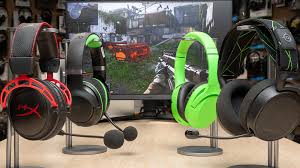Oftentimes, the best gaming headset doesn’t need to be a “gaming headset” at all. Although these devices can be viewed as niche within the headphone market, they’re ultimately still headphones. And though we’ve found more and more gaming headsets that impress in terms of audio quality, those tend to cost more than a comparable set of wired headphones (which, yes, still exist). If you need to chat with friends, it’s always possible to buy an external microphone and get superior sound there as well.
That said, we know many people just want the convenience of a headset with a mic built right in. So after testing dozens of pairs over the past 18 months, we’ve rounded up a few quality gaming headsets and headphones for gaming, which aren’t quite the same thing. Whichever way you go, all of our recommendations should make your play time more enjoyable, no matter your budget or preferred gaming platform.
What to look for in good gaming headphones
Evaluating headphones is a particularly subjective exercise, so calling one pair the absolute “best” is something of a fool’s errand. At a certain point, whether you’re an audiophile or not, everything becomes a matter of taste.
For most, a headphone with a wide soundscape and strong imaging performance — i.e., the ability to position sounds correctly, so you can more precisely tell where footsteps and other game effects are coming from — will provide the most immersive gaming experience, the kind that makes you feel like your head is within a given scene.
For that, you want a high-quality pair of open-back headphones. That is to say, an over-ear pair whose ear cups do not completely seal off the ear from air and outside noise.
These are inherently terrible at isolating you from external sound and preventing others from hearing what you’re playing, so if you often play games in a noisy environment, their benefits will be blunted. But in a quiet room, the best open-back pairs sound significantly wider and more precise than more common closed-back models.
More up for debate is how a good gaming headphone should sound. If you want something that’ll help you in competitive multiplayer games, you may prefer a headphone with a flatter sound signature, which’ll keep a game’s mix from being overly boosted in one direction and is less likely to mask the smaller details of what’s happening around you. A slightly brighter sound, one that pushes the upper frequencies a tad, may also work.
Open-back headphones almost never have huge sub-bass, so you rarely have to worry about low-end sounds muddying up the rest of the signature. In this light, the fact that an overwhelming amount of gaming headsets are closed-back and bass-heavy seems counterintuitive.
Lots of people love bass, though. And if you don’t really care about competitive play, some extra low-end can add a touch of excitement to action scenes or rousing soundtracks. You still don’t want a pair that boosts the low-end too hard — as many gaming headsets do — but the point is that what makes a pair “immersive” to one person may sound dull to another.
The Beyerdynamic DT 900 Pro X should please most people willing to pay for a capital-N nice pair of headphones for gaming purposes. It localizes sounds accurately and delivers the kind of spacious soundstage expected from a good open-back model. Bass is a little more present here than on many open-back headphones as well.
There still isn’t much in the way of deep sub-bass, unsurprisingly, but there’s enough warmth to give stuff like explosions a bit more juice without muddying up the mids. Details in the midrange get the most emphasis overall, but they’re clear, and their forwardness isn’t a bad thing when you’re trying to listen for enemy players in a competitive FPS like Counter-Strike 2 or Apex Legends. The treble isn’t pushed quite as hard, but it’s neither overly recessed nor harsh.
All of this helps the DT 900 Pro X sound detailed but not boring. It’s the kind of sound that plays nice whether you’re trying to win a multiplayer game or take in a more cinematic single-player story. And when you’re not gaming, you get an enjoyable profile for music.
The whole thing is built well, too. The DT 900 Pro X will clamp down slightly harder than average if you have a large head, but it balances its weight well, and its wonderfully soft velour earpads go a long way toward keeping the pair comfortable over hours-long gaming sessions. It comes with two detachable cables, including a three-meter option that’s convenient if you sit far from your PC. It can’t fold up, though.
Like all open-back headphones, the DT 900 Pro X leak game audio and let in lots of noise, so it’s not great on the go. Clearly, if you can afford to upgrade to an ultra-premium pair like Sennheiser’s HD 800 S, you’ll get more space and true-to-life detail. But for a relatively attainable $250 to $300, the DT 900 Pro X should satisfy.
